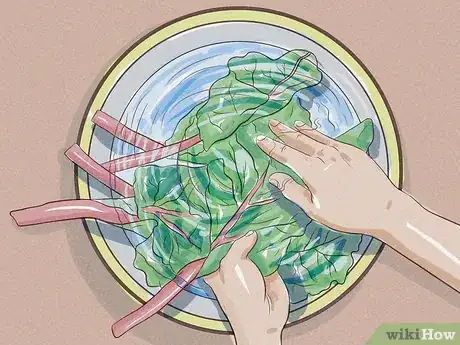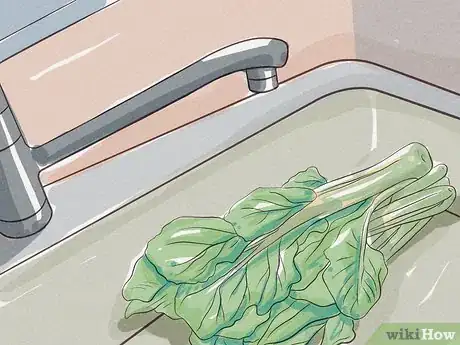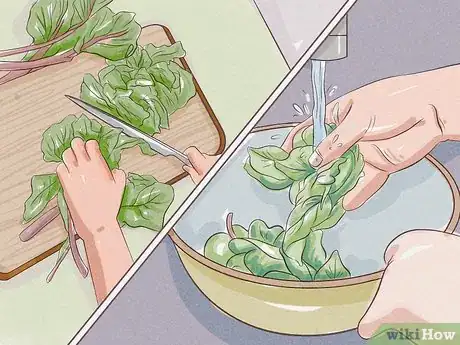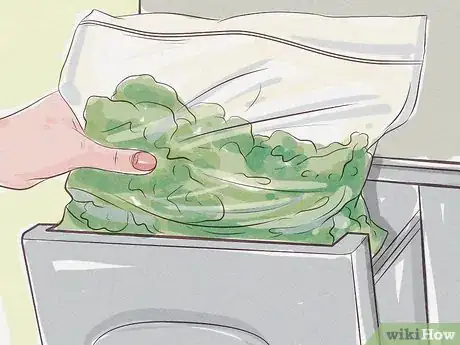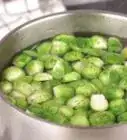This article was co-authored by wikiHow Staff. Our trained team of editors and researchers validate articles for accuracy and comprehensiveness. wikiHow's Content Management Team carefully monitors the work from our editorial staff to ensure that each article is backed by trusted research and meets our high quality standards.
This article has been viewed 17,262 times.
Learn more...
Swiss chard is a green that is packed full of vitamins and minerals. This green can be eaten any way. You can braise it, place it in raw salads, and add it to stir fries and sauces. To clean Swiss chard, rinse it with water to remove grit and pat dry.
Steps
Washing the Chard
-
1Rinse greens in a large bowl. Fill a large bowl of water with cool water. Carefully wash off each leaf, removing all dirt and grit. Make sure to get into the nooks of the leaves and the stem.[1]
- Try not to be too rough with the leaves so you don’t tear or bruise them.
-
2Rinse the greens under the faucet. If you don’t want to fill a bowl, wash the chard in the sink. Turn the water on and stick the leaves under the faucet. Make sure the pressure isn’t too high. Rinse the greens until all dirt and grit is removed.[2]Advertisement
-
3Chop the chard and wash it in a salad spinner. Another way to rinse the chard is with a salad spinner. If you want to cut the chard in small pieces instead of cooking the whole leaves, you can chop it before washing. Take the edge of the chard leaf and roll it into a long tube. Chop the chard into small ribbons. Place the smaller pieces of the leaf into a salad spinner and fill it with water. Let it soak and then pull the basket out. Pour out the dirty water.[3]
- Replace the basket and spin it to get rid of some of the excess water.
-
4Soak the greens in water. If you have some time before you have to start cooking, fill your sink with warm water. Submerge the chard in the water. Move it around with your hand and let it soak for a few minutes.[4]
-
5Make a food acid mixture. If you want to add an extra bit of cleaning, soak the chard in a food acid, like apple cider vinegar, lemon juice, or lime juice. Fill a bowl with water and add ¼ cup of apple cider vinegar or lime or lemon juice.[5]
-
6Soak for 10 minutes. Cover all of the leaves in the mixture. The stalks don’t have to be in the water. Leave the chard for five to ten minutes. Remove the chard from the mixture and rinse with water.[6]
-
7Dry the chard with a cloth. If you have time, you can place the Swiss chard in a colander and let it drain. Otherwise, use a paper towel or soft dry cloth to pat the Swiss chard dry.[7]
Storing Swiss Chard
-
1
-
2Keep refrigerated for a week. Swiss chard can be stored in your refrigerator for five to seven days after washing. Store it in a plastic bag in the vegetable bin. To make Swiss chard last longer than seven days, make sure it is completely dry so it will last longer or don't wash it before placing it in the fridge. You also can store it without washing to make it last longer. Chard can last up to two weeks if stored properly.[9]
- If you wash the chard before placing it in the refrigerator, let it drain in a colander or dry it with a cloth to remove the moisture.
-
3Cut away the stems. Prepare the chard after washing so it will be ready to cook later in the week. Cut off any spots you see on the leaves. Fold the leaf in half and cut away the stems. Then store it so it will be ready when you want to cook it.[10]
- The stems are edible and can be quite tasty. They are tougher than the leaves, so they require a longer cooking time. This is why separating the stems and leaves is important.
Community Q&A
-
QuestionHow do I store the stems for later?
 Becca AtwoodCommunity AnswerPlace them in an airtight container, plastic sandwich bags etc., and you can store them in the fridge (if using in the next few days) or the freezer (for extended storage). I recommend using the stems in the juicer as a small addition to a green juice.
Becca AtwoodCommunity AnswerPlace them in an airtight container, plastic sandwich bags etc., and you can store them in the fridge (if using in the next few days) or the freezer (for extended storage). I recommend using the stems in the juicer as a small addition to a green juice.
References
- ↑ http://www.cookinglight.com/cooking-101/techniques/how-to-prepare-swiss-chard/swiss-chard-prep-wash
- ↑ http://www.cookinglight.com/cooking-101/techniques/how-to-prepare-swiss-chard/swiss-chard-prep-wash
- ↑ http://www.fullcircle.com/goodfoodlife/2012/05/17/everything-you-need-to-know-about-chard/
- ↑ http://www.cookinglight.com/cooking-101/techniques/how-to-prepare-swiss-chard/swiss-chard-prep-wash
- ↑ http://www.vegancoach.com/how-to-cook-swiss-chard.html
- ↑ http://www.vegancoach.com/how-to-cook-swiss-chard.html
- ↑ http://www.cookinglight.com/cooking-101/techniques/how-to-prepare-swiss-chard/swiss-chard-prep-wash
- ↑ http://www.farmerfoodshare.org/veg/swiss-chard/
- ↑ http://www.farmerfoodshare.org/veg/swiss-chard/
About This Article
To clean Swiss chard, carefully wash the leaves in a bowl of cold water to remove any dirt and debris. You can also rinse the chard off under a faucet as long as the water pressure isn't too high. Or, if you have some time to spare, simply soak the chard in a bowl of cold water while you're preparing the rest of your meal. For extra cleaning power, add apple cider vinegar, lemon juice, or lime juice to the water. To learn how to properly store Swiss chard, scroll down!
